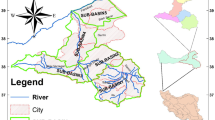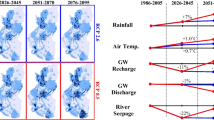Abstract
The water evaluation and planning (WEAP) approach and the invasive weed optimization algorithm (IWOA) are herein employed to determine the optimal operating policies in conjunctive (surface water/groundwater) systems for water supply in agricultural municipal/industrial (M&I) sectors under climate change. Climatic variables are simulated with atmospheric-ocean general circulation models (AOGCMs) under emission scenarios A2 and B2 during the baseline period 1971–2000 and the future periods 2040–2069 and 2070–2099 in the Khorramabad basin, Iran. The Hadley Centre Coupled Model, version 3 (HadCM3), and the Canadian Global Coupled Model, version 2 (CGCM2), produced superior temperature and rainfall projections, respectively, than other climate models. Under both emissions scenarios and during each future period, this study indicates an increase in temperature and a decrease in rainfall. Simulations of surface water with the IHACRES (Identification of unit Hydrographs And Component flows from Rainfall, Evaporation and Streamflow data) calibrated model shows a decrease in the future runoff. The Groundwater Modeling System (GMS) calibrated software projects a decrease in water level and a decrease in recharge under climate change scenarios. Simulation results from IHACRES and GMS are input to the Water Evaluation and Planning (WEAP) system to develop operational policies for the combined use of water resources., The water-allocation reliability of the system is estimated with the WEAP system for 24 scenarios reflecting climate change scenarios assuming increases in water demand, ranging from 10 to 60% in agriculture and from 20 to 30% in the municipal and industrial (M&I) sector. The IWOA is applied to optimize the conjunctive system of water resources (i.e., surface water and groundwater). The objective function is to maximize the system's water allocation reliability. The range of optimal water-allocation reliability changes is between 3 and 16%, with the lowest increase corresponding to the baseline period for agricultural water demand, and the highest rise corresponding to an increase of 50% in water demand under the B2 emissions scenario in 2040–2069 for the M&I water sector.












Similar content being viewed by others
Availability of Data and Materials
Authors have no restrictions on sharing data.
References
Alamanos A, Latinopoulos D, Loukas A, Mylopoulos N (2020) Comparing two hydro-economic approaches for multi-objective agricultural water resources planning. Water Resour Manage 34:4511–4526. https://doi.org/10.1007/s11269-020-02690-6
Asgari HR, Bozorg-Haddad O, Pazoki M, Loáiciga HA (2016) Weed optimization algorithm for optimal reservoir operation. J Irrig Drain Eng 142(2). https://doi.org/10.1061/(ASCE)IR.1943-4774.0000963
Azadi F, Ashofteh P-S, Shokri A, Loáiciga HA (2021) Simulation-optimization of reservoir water quality under climate change. J Water Resour Plan Manag 147(9)
Azari A, Hamzeh S, Naderi S (2018) Multi-objective optimization of the reservoir system operation by using the hedging policy. Water Resour Manage 32(6):2061–2078. https://doi.org/10.1007/s11269-018-1917-5
Chen H-T, Wang W-C, Chau K-W, Xu L, He J (2021) Flood control operation of reservoir group using Yin-Yang Firefly Algorithm. Water Resour Manage 35(15):5325–5345
Golfam P, Ashofteh P-S, Loáiciga HA (2019) Evaluation of the VIKOR and FOWA multi-criteria decision making methods for climate-change adaptation of agricultural water supply. Water Resour Manage 33(8):2867–2884. https://doi.org/10.1007/s11269-019-02274-z
Golfam P, Ashofteh P-S, Loáiciga HA (2021) Modeling adaptation policies to increase the synergies of water-climate-agriculture nexus under climate change. Environmental Development 37:100612. https://doi.org/10.1016/j.envdev.2021.100612
IPCC-TGCIA (1999) Guidelines on the use of scenario data for climate impact and adaptation assessment. (eds) Carter TR, Hulme M, Lal M, Version 1, 69pp. Intergovernmental Panel on Climate Change, Task Group on Scenarios for Climate Impact Assessment
IPCC (2007) Summary for Policymakers. In: Climate Chang 2007: The Physical Science Basis. Contribution of Working Group I to the Fourth Assessment Report of the Intergovernmental Panel on Climate Change, Cambridge University Press, Cambridge, United Kingdom and New York, USA, pp 18
Jakemann AJ, Hornberger GM (1993) How much complexity is warranted in a rainfall-runoff model? Water Resour Res 29(8):2637–2649. https://doi.org/10.1029/93WR00877
Jones PD, Hulme M (1996) Calculating regional climatic time series for temperature and precipitation: Methods and illustrations. Int J Climatol 16(4):361–377
Lane ME, Kirshen PH, Vogel RM (1999) Indicators of impact of global climate change on U.S. water resources. J Water Resour Plan Manag 125(4):194–204. https://doi.org/10.1061/(ASCE)0733-9496(1999)125:4(194)
Li X, Wang X, Guo H, Ma W (2020) Multi-water resources optimal allocation based on multi-objective uncertain chance-constrained programming model. Water Resour Manage 34:4881–4899. https://doi.org/10.1007/s11269-020-02697-z
Majedi H, Fathian H, Nikbakht-Shahbazi A, Zohrabi N, Hassani F (2021) Multi-objective optimization of integrated surface and groundwater resources under the clean development mechanism. Water Resour Manage 35:2685–2704. https://doi.org/10.1007/s11269-021-02860-0
Mehrabian AR, Lucas C (2006) A novel numerical optimization algorithm inspired from weed colonization. Eco Inform 1(4):355–366. https://doi.org/10.1016/j.ecoinf.2006.07.003
Mitchell TD (2003) Pattern scaling: An examination of the accuracy of the technique for describing future climates. Clim Change 60(3):217–242
Mousavi SJ, Rafiee Anzab N, Asl-Rousta B, Kim JH (2017) Multi-objective optimization-simulation for reliability-based inter-basin water allocation. Water Resour Manage 31(11):3445–3464. https://doi.org/10.1007/s11269-017-1678-6
Moutsopoulos KN, Papaspyros JNE, Tsihrintzis VA (2017) Management of groundwater resources using surface pumps: Optimization using genetic algorithms and the tabu search method. KSCE J Civ Eng 21(7):2968–2976. https://doi.org/10.1007/s12205-017-1013-z
Pyne D (2005) Aquifer Storage Recovery. ASR Systems LLC, Gainesville, Florida
Safavi HR, Enteshari S (2016) Conjunctive use of surface and ground water resources using the antsystem optimization. Agric Water Manag 173:23–34. https://doi.org/10.1016/j.agwat.2016.05.001
Sepahvand R, Safavi HR, Rezaei F (2019) Multi-objective planning for conjunctive use of surface and ground water resources using genetic programming. Water Resour Manage 33:2123–2137. https://doi.org/10.1007/s11269-019-02229-4
Tabari MMR, Soltani J (2013) Multi-objective optimal model for conjunctive use management using SGAs and NSGA-II models. Water Resour Manage 27(1):37–53. https://doi.org/10.1007/s11269-012-0153-7
Taormina R, Chau K-W (2015) ANN-based interval forecasting of streamflow discharges using the LUBE method and MOFIPS. Eng Appl Artif Intell 45:429–440
van der Voorn T, Svenfelt Å, Björnberg KE, Fauré E, Milestad R (2020) Envisioning carbon-free land use futures for Sweden: a scenario study on conflicts and synergies between environmental policy goals. Reg Environ Chang 20(35). https://doi.org/10.1007/s10113-020-01618-5
Wang W-C, Du Y-J, Chau K-W, Xu D-M, Liu C-J, Ma Q (2021) An ensemble hybrid forecasting model for annual runoff based on sample entropy, secondary decomposition, and long short-term memory neural network. Water Resour Manage 35(14):4695–4726
Wilby RL, Harris I (2006) A framework for assessing uncertainties in climate change impacts: Low flow scenarios for the River Thames, UK. Water Resour Res 42(2):W02419. https://doi.org/10.1029/2005WR004065
Wu X, Zheng Y, Wu B, Tian Y, Han F, Chunmiao Zh (2016) Optimizing conjunctive use of surface water and groundwater for irrigation to address human-nature water conflicts: A surrogate modeling approach. Agric Water Manag 163:380–392. https://doi.org/10.1016/j.agwat.2015.08.022
Wu CL, Chau K-W (2013) Prediction of rainfall time series using modular soft computing methods. Eng Appl Artif Intell 26(3):997–1007
Xie H, Randall M, Chau K-W (2022) Green roof hydrological modelling with GRU and LSTM networks. Water Resour Manage 36(3):1107–1122
Yang C-C, Chang L-C, Chen CS, Yeh MS (2009) Multi-objective planning for conjunctive use of surface and subsurface water using genetic algorithm and dynamics programming. Water Resour Manage 23(3):417–437. https://doi.org/10.1007/s11269-008-9281-5
Zheng F, Qi Zh, Zhange T, Yu T, Shao Y (2017) Improved Understanding on the Searching Behavior of NSGA-II Operators Using Run-Time Measure Metrics with Application to Water Distribution System Design Problems. Water Resour Manage 31(4):1121–1138
Funding
Not applicable.
Author information
Authors and Affiliations
Contributions
Seyedeh Hadis Moghadam developed the theory and performed the computations. Parisa-Sadat Ashofteh verified the analytical methods and encouraged Seyedeh Hadis Moghadam to investigate a specific aspect. Parisa-Sadat Ashofteh supervised the findings of this work. All authors discussed the results and contributed to the final manuscript. Seyedeh Hadis Moghadam wrote the manuscript with support from Parisa-Sadat Ashofteh, and especially Loáiciga. Parisa-Sadat Ashofteh conceived the original idea.
Corresponding author
Ethics declarations
Conflict of Interest
None.
Additional information
Publisher's Note
Springer Nature remains neutral with regard to jurisdictional claims in published maps and institutional affiliations.
Rights and permissions
About this article
Cite this article
Moghadam, S.H., Ashofteh, PS. & Loáiciga, H.A. Optimal Water Allocation of Surface and Ground Water Resources Under Climate Change with WEAP and IWOA Modeling. Water Resour Manage 36, 3181–3205 (2022). https://doi.org/10.1007/s11269-022-03195-0
Received:
Accepted:
Published:
Issue Date:
DOI: https://doi.org/10.1007/s11269-022-03195-0




